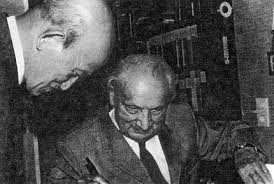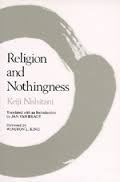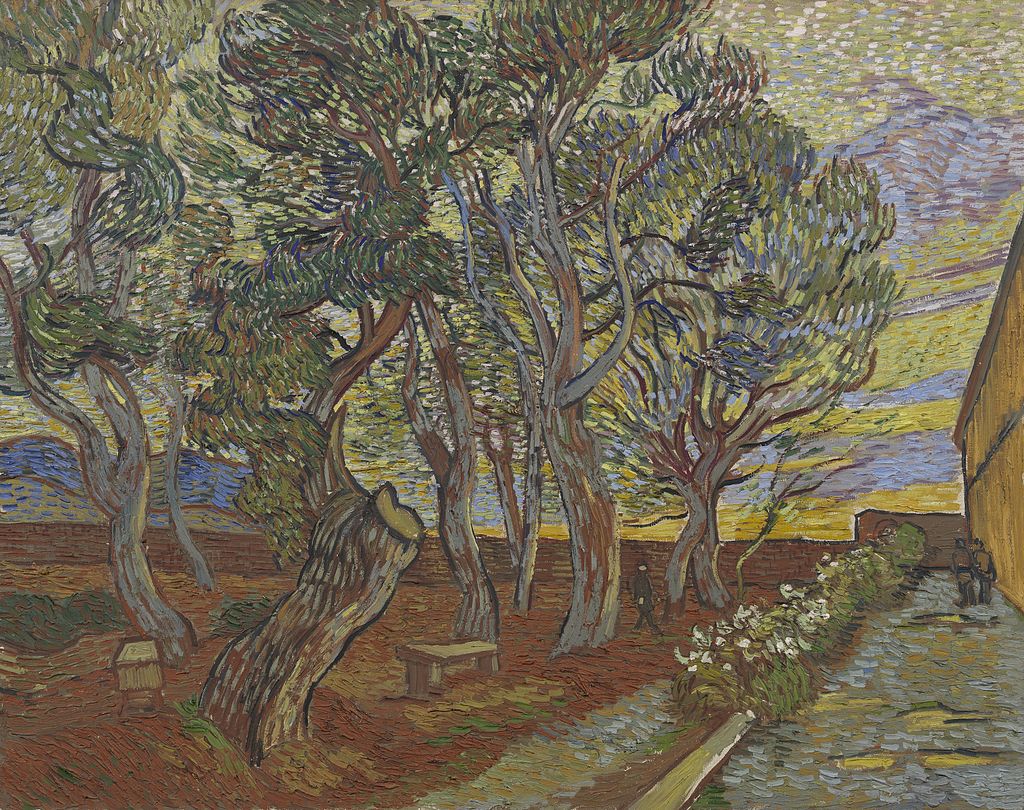“The approaching tide of technological revolution in the atomic age could so captivate, bewitch, dazzle and beguile man that calculative thinking may someday come to be accepted and practiced as the only way of thinking … Then man would have denied and thrown away his own special nature – that he is a meditative being. Therefore, the issue is the saving of man’s essential nature” (Martin Heidegger).
The field of consciousness versus the field of emptiness

The wish for control, or rather the belief that all problems can only be solved through tighter control over reality, is currently embodied in a mode of thinking which is invaluable when used within limits to secure physical and material survival, but which Western culture has absolutised as the mode where all answers are to be sought: this is the mode of separation of subject and object, which Heidegger describes as “calculative thinking” or “representational thinking.” This is also what Nishida refers to as “object logic,” and which Nishitani associates with the mode of thinking on the field of (ordinary) consciousness,” he also calls the “field of reason,” or the “field of being,” where the things that make up reality can only be apprehended as representations. Scientists, economists, politicians, all thinkers – and in fact, all of us, insofar as our minds have been schooled into thinking in that way, and made to believe that this is the only way one can think – unwittingly set ourselves up as subjects standing over against reality which then appears to us as if projected onto a screen. Our intellects operate by manipulating concepts, i.e. mental representations believed to grasp the “being” of things. Such manipulation, called “theoretical reasoning,” finds justification in that it makes it possible to develop strategies to act upon reality.
“I think, therefore I am”
Historically, the differentiation process that led to the absolutisation of our mode of consciousness originated in ancient Mesopotamia where the Eastern notion of the Divine as immanent in nature was discarded in favour of a God ruling over his creation, yet separate from it, and entrusting to humankind the task of taking care of it on its behalf. From there developed the Christian notion of “man” having been given “dominion” over nature and all animal species. During the Renaissance, Europe rediscovered Homer, and Greek philosophy and science, and with them the epic hero, precursor of the autonomous self, and of the rational thinker. With Descartes, “man” shed his status of sinful, imperfect, and vulnerable creature dependent on God’s grace, to stand hero-like as a subject able to grasp the inner workings of the world, and take charge. Descartes himself gave due respect to God as the maker of this rational order which made it possible for us to understand reality. As, however, he found himself under pressure to provide a “ground of certainty” for emerging science based on mathematics, the observation of facts and the experimental method, Descartes set out to pass all he knew through a filter of systematic doubt, and concluded that the only thing he could be sure of was his own existence. He, at least, who had been doubting and thinking, had to be (that doubting and thinking being). Ego cogito, ergo sum. I think therefore I am. This amounted to positing the mode of thinking of ordinary consciousness where subject and object are separated, as a “ground of certainty” in order to prove that it was a “ground of certainty.” A syllogism, which Descartes was duly warned about, but never admitted to. So, in effect, what Descartes did is turn a particular mode of thinking whose validity was based on its own implied criteria for validity, into the only valid mode of thinking, and that mode of thinking, based on the human ego, was far from safe.
When, two centuries later, Nietzsche stated that “God is dead,” i.e., metaphysics, the rational edifice on which the West had built itself, was merely a human construct, a wave of nihilism ensued. Scientists, however, went merrily on their way to use their rational powers to work on a re-creation of the world to meet their own requirements, or rather those of the governments, banks, and corporations, which financed their research projects. From there to nuclear energy, genetic engineering, and artificial intelligence, there was but one straight road. And, in view of the latest developments in world politics, the so-called post-truth era, it seems that humanity, displeased by the destructive effects its actions are having on actual reality (the planet), has decided that actual reality was just too much of a bother, and human-made “alternative facts” were a lot more gratifying. But even in that denial mode, the dream of control is at work, because it is not because people are prepared to lose their lives to the looming environmental disasters, and the outbreaks of violence which will come with them, in fact, probably ahead of them, that they indulge in an alternative version of reality, it is because when they tweet and troll, they feel they are to some extent in control …
Complete control is a mirage, and neither the West nor any other culture can attain it any more than the ancient Egyptian pharaohs obtained immortality by having huge pyramids built at great cost, both in terms of squandering the state’s wealth, and the suffering and loss of lives among the massive workforce required for the task. As Joseph Campbell pointed out, although the ancient Egyptians turned “a Neolithic folk culture into one of the most elegant and enduring of the world’s high civilisations, literally moving mountains to become pyramids and filling the earth with the echoes of its beauty … the individuals in its ban were so bewitched that, titans though they were in deed, in sentiment they were infantile.” They thought everlasting life could be obtained. We too, seem to be bewitched by a belief in total control, for ever frantically looking for new sources of energy to manufacture forever more complex devices, and making useless sacrifices in pursuit of the impossible.
On the field of consciousness, the “things as they are in themselves” remain beyond our reach.

Also, and this is the core of Nishitani’s thought, the mode of consciousness associated with the wish to control, has a built-in fault: it sets up a separation between subject and object which exacerbates the desire for communion and, at the same time, makes this communion impossible. In other words, it is a mode which causes us to want ever more and, at the same time, ensures that we never achieve satisfaction. The Buddhist metaphor for that mode of being is the “hungry ghost,” a creature with a big belly (a big appetite) and a small mouth (through which no food can be taken).
According to Nishitani, the reason why we cannot achieve satisfaction on the field of consciousness is that, on that field, we can only access representations of these things, the “things as they are in themselves” remain beyond our reach. Only on the “field of emptiness” can we apprehend them, as we “realise” the things “as they are,” “in their suchness,” “on their home-ground.”
In Religion and Nothingness, Nishitani takes pains to set forth the reality of nothingness in a “philosophical” language congenial to Western readers, and which, additionally, enables Western Buddhists to situate themselves within the framework of Western philosophical tradition.
In the introduction to Being and Time, Martin Heidegger asserted that the question of Being was the most basic and most concrete of all. What makes a being be what it is? When I say that grass is green, am I also saying that grass “is”? What do I mean when I say that grass “is”? Grass is a sensory form (i.e. a form on the field of sensation) and an eidetic form (i.e. an idea or concept on the field of reason). For Nishitani, the field of sensation and the field of reason make up the field of consciousness on which things display the shapes they have for us, in which they appear to us as reflections of their relationship to us. They are the forms of things lifted from their home-ground, and transferred into our consciousness.
These forms have arisen out of our necessary interaction with reality and the need to use things instrumentally to secure our material well-being. We do need to make use of such conceptual instruments in order to gain some degree of control over our circumstances and ensure day-to-day living. The fact that a degree of control is necessary, however, does not mean that more of the same, and ultimately complete control, is what we should be aiming at as our final goal.
Nishitani’s point is that these forms on the field of our consciousness are not the things in themselves, which can only be apprehended when the subject-object dichotomy is dissolved, and “I” (no longer “I” in effect) “merge with,” “become,” or “realise” the things of the world. What Nishitani has in mind is an experience of deep communion with reality which the West normally associates with mystical experience or aesthetic contemplation. It is a state in which you are so thoroughly lost in what is around you that you forget your own existence. In the words of T. S. Eliot, “Music heard so deeply, it is not heard at all, and you are the music, while the music lasts.” But Nishitani is not merely concerned with privileged experiences bestowed on us in special circumstances. For him, and all Buddhists, such a state can be realised through a training of awareness, and can become the mode in which we live our lives. Thus thirteenth century Japanese philosopher Dogen described the mode of “no-mind” in the following words: “Since there is no mind in me, when I hear the sound of raindrops from the cave, the raindrop is myself.”
Only on the field of emptiness, can we apprehend reality as it is and allow it to realise itself through us in a real way
As Taitetsu Unno explains in The Religious Philosophy of Nishitani Keiji, the field of emptiness is a mode of apprehending reality wherein the things of the world, whether it is a beautiful sunset, or an aging father, or the sound of a bamboo flute, are intensely present to us and perceived with the utmost clarity, because our mind is free of thoughts and preoccupations, with the result that, as we become fully aware of reality, reality realises itself in our awareness. “Awareness” is here understood as an emptying of one’s self to allow things to be themselves and, as it were, “enlighten” us, in contrast with “consciousness” wherein reality is perceived through the filter of our self-centered concerns, arising from our practical interaction with the world, and the mental constructs mediating our use of reality.
For Nishitani, true thinking is not the reduction of reality to a system of causes and effects that captures a particular level of organisation in connection with the articulation of a strategy. True thinking is that in-sight which surfaces spontaneously from the field of emptiness as a direct seeing into reality that allows us to get in touch with things as they are for themselves “on their home-ground.” Not to “know” them but to “embody” them.
Sources:
Nishitani Keiji – Religion and Nothingness (1982)
Martin Heidegger – Discourse on Thinking (1966)
Joseph Campbell – The Masks of God – Oriental Mythology Vol. 2
Martin Heidegger – Being and Time (1962)
Taitetsu Unno – The Religious Philosophy of Nishitani Keiji (1989)

